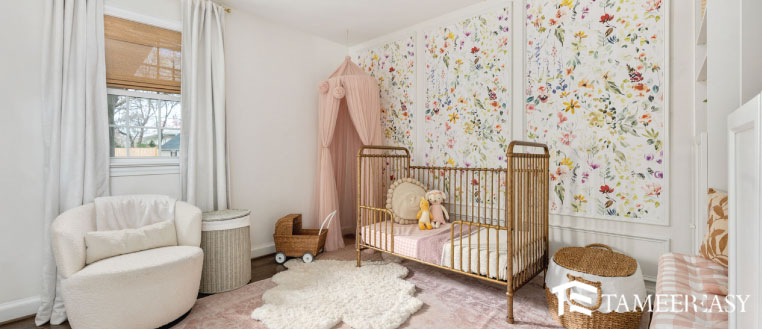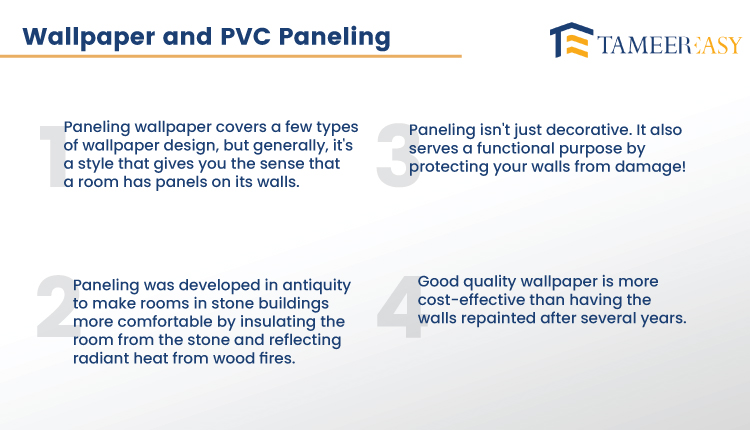Today, we will discuss wallpaper and PVC paneling. You have often seen designs and patterns on walls with beautiful colors that enhance the aesthetics of rooms and the interior of homes. What are these designs and patterns? How are they created? What items are needed for them?
Visit TameerEasy Store to Purchase Quality Construction Items
In this article, we will have a comprehensive look at this topic, and by the end, you will surely have all the necessary information related to the topic.

What is Wallpaper?
Wallpaper is a decorative substance used to decorate a space’s walls. It is available in a variety of designs, hues, and textures. It is utilized in various house rooms for interior design and as a paint substitute.
Types of Wallpapers
Different types of wallpapers are available, including vinyl, textured, and matte.
1). Vinyl Wallpaper
Let’s start by discussing vinyl wall coverings: Vinyl wallpaper is moisture-resistant, enduring, and simple to clean. It is appropriate for places with high traffic, like restrooms and kitchens.
2). Textured Wallpaper
Next, discuss textured wallpaper: Textured wallpaper features raised patterns or textures on the surface, adding depth and dimension to the walls. These patterns create a visual impact and enhance the room’s overall appearance.
3). Matte Wallpaper
Matte wallpaper offers a smooth, non-reflective finish. It comes in a wide range of designs and is one of the most common types of wallpaper.
In conclusion, these different wallpapers provide various options to enhance your space’s aesthetics, catering to different preferences and design styles.
What is PVC Wall Paneling?
This sheet is made of polyvinyl chloride (PVC) used on walls primarily affected by seepage in interior spaces. New homes commonly use it to align with architectural designs, enhancing and protecting room walls.
Types of PVC Wall Paneling
PVC panels have three types: printed PVC panels, embossed PVC panels, and laminated PVC panels.
1). Printed PVC Panels
Let’s start by discussing printed PVC panels. In these panels, affix design sheets to PVC panels. They are available in a variety of styles, patterns, and textures that raise the appeal of walls.
2). Embossed PVC Panels
Next, we have embossed PVC panels. These panels feature raised patterns and textures that create a 3D effect on the walls, adding depth and dimension.
3). Laminated PVC Panels
Additionally, there are laminated PVC panels. These panels come with lamination and offer glossy, matte, or wooden looks, providing versatile options for wall aesthetics.


Application of Wallpaper
The process of applying wallpaper involves the following six steps:
- Surface Preparation: Begin by preparing the surface. Clean the wall thoroughly and fill any uneven areas to create a smooth base.
- Adhesive Selection: Choose a high-quality adhesive or glue for the wallpaper. Before applying, read the instructions provided by the tape and wallpaper manufacturer.
- Cutting Wallpaper: Cut the wallpaper rolls into pieces according to your required size and dimensions.
- Applying Adhesive: Use a brush or roller to apply the adhesive on the wall. Be sure to uniformly distribute the glue over the surfaces at the place of wallpaper installation.
- Pasting Wallpaper: Carefully place the wallpaper pieces on the wall where they need to be applied. Smooth the wallpaper to ensure it adheres to the adhesive without forming wrinkles or bubbles.
- Trimming and Finishing: Trim any excess parts of the wallpaper using a blade, ensuring neat edges. Afterward, clean the surface to maintain the wallpaper’s appearance.
These steps guide the proper wallpaper application, resulting in a well-adhered and smooth finish on your walls.
Preventive Measures to Take While Applying Wallpaper
- First and foremost, when applying wallpaper, it’s essential to start with surface preparation. Thoroughly clean the surface, ensuring careful attention to detail. Fill any uneven areas on the wall to create a smooth base.
- The appropriate amount of adhesive application is crucial. Using the right quantity of adhesive is important, as too much can damage the wallpaper, while too little may result in poor adhesion. Striking the right balance is key.
- Matching is another crucial aspect. Since we apply wallpaper for its aesthetic beauty, matching the wallpaper patterns is extremely important. The pattern’s alignment with your design theme significantly enhances the wallpaper’s visual appeal.
- Always opt for skilled labor when installing wallpapers and pvc. Hiring skilled professionals ensures proper application and enhances the lifespan of the wallpaper.
- Maintenance is a vital consideration. It’s essential to follow the manufacturer’s instructions for maintaining the wallpaper. Regular cleaning with mild cleaners and soft cloths is recommended. In case of any damage, make repairs promptly to extend the wallpaper’s longevity.
Together, these measures guarantee a smooth wallpapers and pvc installation and upkeep procedure, giving your walls a stunning and enduring appeal.
Application of PVC Paneling
Installing PVC paneling involves four steps, where the first one is:
- Although these panels can adhere to uneven surfaces, achieving a polished, long-lasting finish requires thorough surface cleaning and leveling.
- Next, install the PVC panels on one side according to size, shape, and design.
- Typically, these panels are installed using nailing. One panel slides and fixes into place alongside another panel. However, some panels are adhesive-based.
- If needed, excess panels are trimmed using a blade or saw. Additionally, adding trim at the ends of the panels after paneling gives the wall a refined appearance, enhancing the overall finish.
Preventive Measures to Take While Applying PVC Paneling
- As we mentioned earlier, cleaning the wall similarly is essential, including leveling any uneven surfaces.
- For execution, always employ skilled labor to ensure the work is done delicately and properly.
- Like wallpapers and PVC , matching is also crucial here, following your theme and design.
- Also, opt for soft cloths and a mild cleaner for cleaning and maintenance, avoiding hard materials such as abrasive tools.
Conclusion
We hope you understand what wallpapers and PVC wall paneling are, how to install them, and the necessary precautions. If you still need further guidance, visit our website, tameereasy.







